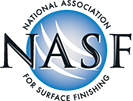| Presented in Partnership with: | |||
 |
 |
 |
 |
FAX TRANSMISSION
Headquarters, US EPA
401 M St., S.W.
Washington, D.C. 20460
Date: May 31, 1996
To: Jeff Cullen, Beverage and Diamond
Fr: Mark Ingle, Project Officer, U.S. Environmental Protection Agency
Re: EPA Applicability Interpretation Regarding Silk Screen Printing and the Printed Circuit Board Manufacturing Process.
Introduction
On May 20, 1996 you called requesting an applicability interpretation regarding the cleaning of silk screens that are used in the stenciling of printed circuit boards (PCBs). As you reported, the boards were stenciled with an organic coating as part of the manufacturing process, but this marking operation did not involve any electroplating, etching, or other metal-based operation. The following discussion presents my analysis and conclusions showing that in some cases effluent from the silk screen process would be regulated, while in other cases it would not.
Discussion
Attachment A shows the first two pages of the 40 CFR 433, "Metal Finishing Point Source Category" regulation. As shown in 433.10(a) and 433.10(c) PCB manufacture at "independent" shops is covered by 40 CFR 413, "Electroplating Pretreatment Standards" and all other PCB manufacturing operations are covered by 40 CFR 433. Thus, all PCB manufacturing operations are covered either by 40 CFR 413 or 40 CFR 433 and as such EPAs 1984 "Guidance Manual for Electroplating and Metal Finishing Pretreatment Standards" is applicable as a reference material for use in this applicability interpretation.
Attachment B shows the cover page and selected additional pages from the "Guidance Manual for Electroplating and Metal Finishing Pretreatment Standards." As shown on pages 2-2 and 2-3 of this manual, all of the operations that EPA used to define the PCB manufacturing process involve the application or removal of metal from the non-conductive board substrate. None of the manufacturing operations included in the discussion involve the application of an organic coating or paint. Because the silk screen process in question involves the application of an organic coating, it is apparent that this process was not included in the original operations examined as part of the PCB category and as such would not independently invoke either the 40 CFR 413 or 40 CFR 433 regulations. Thus, a facility that cleaned these silk screens, in support of another facilitys PCB manufacturing operations, should not be covered by the 40 CFR 413 or 40 CFR 433 regulations.
However, because PCB manufacturing is one of the six "trigger" processes that are used to determine if 40 CFR 433 is applicable at a facility, and "Painting" is one of the 40 "other" industrial operations that are covered by 40 CFR 433, a facility manufacturing PCB (using etching, electroplating, or any of the other processes listed in Attachment B) and silk screening the boards would be regulated under 40 CFR 433. Because such a facility would be regulated, then the effluent from the silk screening and the plating processes would be subject to the 40 CFR 433 effluent limits. Thus, effluent from silk screening operations, at a PCB manufacturing facility that is covered by 40 CFR 433, would be subject to the categorical standards.
Conclusions
The applicability interpretation for the subject silk screen cleaning process is not easily defined because the 40 CFR 433 regulation utilizes PCB manufacture as a "trigger" process for regulation. Thus, the effluent from the silk screen or silk screen cleaning process may be regulated in some cases and may not in others. The following summarizes the applicability of the 40 CFR 413 and 40 CFR 433 regulations to silk screening operations.
1. A facility that only conducts silk screening (i.e., does not do any electroplating or electroless plating operations), or cleans silk screens that are used to stencil PCBs, is not subject to either 40 CFR 413 or 40 CFR 433 because the PCB-related processes included in the development of these regulations all relate to metal etching or plating and do not relate to organic coating or painting.
2. A facility that etches or plates metal on PCBs and stencils the boards using a silk screen process would be covered by 40 CFR 433. Effluent from all of the plating, silk screening, and associated cleaning processes would be covered because "PCB Manufacture" is one of the 40 CFR 433 "trigger" processes and "Painting" is one of the 40 "other" processes covered by the regulation.
3. Existing PCB manufacturers, already covered by 40 CFR 413, that also conduct silk screen printing, or silk screen cleaning, would be covered under the 40 CFR 413 regulatory limits. However, because 40 CFR 413 does not include "Painting" as a regulated unit operation (as is the case for 40 CFR 433), the effluent from the silk screen printing or silk screen cleaning should not be subject to the 40 CFR 413 regulatory limitations. However, such discharges would be likely to still be regulated using the combined waste stream formula discussed in 40 CFR 403.6(e).
 |
 |
 |
 |
 |
| Home | Subscribe | Regulations | Compliance Assistance | News | Resources | Resource Locators | Directories | Online Training | About | Search | NASF.org |
The information contained in this site is provided for your review and convenience. It is not intended to provide legal advice with respect to any federal, state, or local regulation.
You should consult with legal counsel and appropriate authorities before interpreting any regulations or undertaking any specific course of action.
Please note that many of the regulatory discussions on STERC refer to federal regulations. In many cases, states or local governments have promulgated relevant rules and standards
that are different and/or more stringent than the federal regulations. Therefore, to assure full compliance, you should investigate and comply with all applicable federal, state and local regulations.